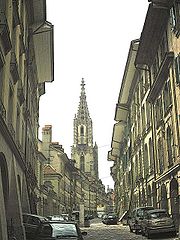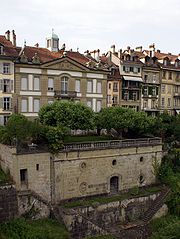
Junkerngasse
Encyclopedia

Switzerland
Switzerland name of one of the Swiss cantons. ; ; ; or ), in its full name the Swiss Confederation , is a federal republic consisting of 26 cantons, with Bern as the seat of the federal authorities. The country is situated in Western Europe,Or Central Europe depending on the definition....
. It connects the tip of the Aar peninsula (the Nydegg
Nydegg
The Nydegg is a historic section in the Old City of Bern in Bern, Switzerland.The first expansion of Bern occurred as the city was founded in 1191. At the east end of the central and oldest neighbourhood, the Zähringerstadt , was the Nydegg castle near the banks of the Aare river. The houses that...
neighbourhood) to the Münster.
The Junkerngasse is the Old City's best-preserved street. The riverfront of its palatial houses with their late Baroque
Baroque
The Baroque is a period and the style that used exaggerated motion and clear, easily interpreted detail to produce drama, tension, exuberance, and grandeur in sculpture, painting, literature, dance, and music...
façades and extensive garden terraces has been described in an art history guidebook as "one of Europe's most magnificent cityscapes".
Topography
The Junkerngasse connects to the generally parallel GerechtigkeitsgasseGerechtigkeitsgasse
-External links:...
and to the Nydegggasse in the east, and continues as the Münstergasse
Münstergasse
The Münstergasse is one of the streets in the Old City of Bern, the medieval city center of Bern, Switzerland. It is part of the Zähringerstadt which was built during the foundation of the old city in 1191. However, until 1967 it was parts of several other streets...
to the west. It is connected to the Gerechtigkeitsgasse by small alleyways leading north (Oberes and Unteres Gerechtigkeitsgässchen). The Bubenbergrain descends through the Bubenbergtor, a former city gate, towards the river Aare in the south.
History
The street was called Kilchgasse ("Church Lane") up until the 16th century, and was renamed from Edle Gasse ("Noble Lane") to Junkerngasse in the 17th century. The latter names reflect the street's character as a residential area almost exclusively used by Bern's leading patrician families. Only a few houses (nos. 7–15) were originally craftsmen's houses.The street's current topography reflects about the state of 1470. The earlier records are fragmentary, but at some time between 1430 and 1468 the city's earliest town hall was demolished at the Junkerngasse's the western end. Since then, the general structure of the street has remained unchanged. The pavement was replaced in 1998.
Buildings


Classicism
Classicism, in the arts, refers generally to a high regard for classical antiquity, as setting standards for taste which the classicists seek to emulate. The art of classicism typically seeks to be formal and restrained: of the Discobolus Sir Kenneth Clark observed, "if we object to his restraint...
. No. 22 was the workshop of painter Friedrich Traffelet
Friedrich Traffelet
Friedrich Eduard Traffelet, popularly Fritz Traffelet was a Bernese painter and illustrator.After studies in Zürich and Paris, he married Alice Rondi in 1921. In the 1930s, Traffelet gained renown as a military painter and served in the Swiss Army during World War II from 1939 to 1945...
(1897–1954); it features a humorous façade painting of 1913. No. 22, the Morlot-Haus by Albrecht Türler, is the most ambitious building in the northern part of the street.
The Erlacherhof
Erlacherhof
The Erlacherhof is a town mansion on the Junkerngasse No. 47 in the Old City of Bern, only a few steps away from the Béatrice-von-Wattenwyl-Haus....
("Erlach
Erlach
Erlach may refer to:places in Austria:*Erlach , a locality of Kallham*Erlach , a locality of Pischelsdorf am Engelbach*Bad Erlach, also known as Erlach an der Pitten in Wiener Neustadt-Land in Lower Austriaplaces in Switzerland:...
Court"), no. 47, is the most significant private building, in historical and architectural terms, of the Old City. Built 1747–52 by Türler for Hieronymus von Erlach, it is the only application of Jacques-François Blondel
Jacques-François Blondel
Jacques-François Blondel was a French architect. He was the grandson of François Blondel , whose course of architecture had appeared in four volumes in 1683 -Biography:...
's concept of palace entre cour et jardin – a palace between court and garden – in an urban setting. As the city's greatest urban palace, the Erlacherhof served as General Guillaume Brune's headquarters in 1798, as the seat of the French Embassy to Switzerland until 1832, and as the first seat of the Swiss Federal Council
Swiss Federal Council
The Federal Council is the seven-member executive council which constitutes the federal government of Switzerland and serves as the Swiss collective head of state....
and the federal administration
Federal administration of Switzerland
The federal administration of Switzerland is the ensemble of agencies that constitute, together with the Swiss Federal Council, the executive branch of the Swiss federal authorities...
from 1848 to 1857. It has since been used as the seat of the government of the city of Bern. Part of its outer wall is the Bubenbergtor, a 12th century city gate and the oldest building in Bern that is still standing. The house opposite the Erlacherhof on Junkerngasse No. 38 belonged to the legendary Bond Girl
Bond girl
A Bond girl is a character or actress portraying a love interest, of James Bond in a film, novel, or video game. They occasionally have names that are double entendres or puns, such as "Pussy Galore", "Plenty O'Toole", "Xenia Onatopp", or "Holly Goodhead"...
Ursula Andress
Ursula Andress
Ursula Andress is a Swiss actress and a sex symbol of the 1960s. She is known for her roles as Bond girl Honey Ryder in Dr...
.
The Zeerlederhaus, no. 51, is noted for the 1897 painting by Rudolf Münger
Rudolf Münger
Rudolf Münger was a Swiss painter.-References:*This article was initially translated from the German Wikipedia....
on its late Gothic façade. No. 59, the Béatrice-von-Wattenwyl-Haus
Béatrice-von-Wattenwyl-Haus
The Béatrice-von-Wattenwyl-Haus is a town mansion on the Junkerngasse No. 59 in the Old City of Bern, only a few steps away from the Erlacherhof.The mansion is built up of several medieval houses...
, has been described as a concentrate of Bernese architectural history; it has not been significantly altered since its 18th century reshaping by Joseph Abeille. In the ownership of the Swiss Confederation since 1934, it is now used for ceremonial events by the Federal Council.

